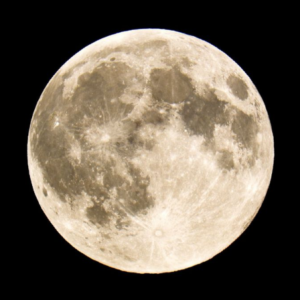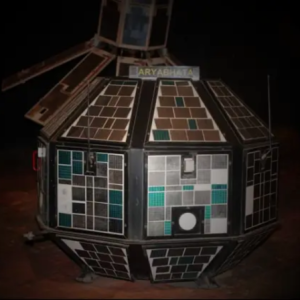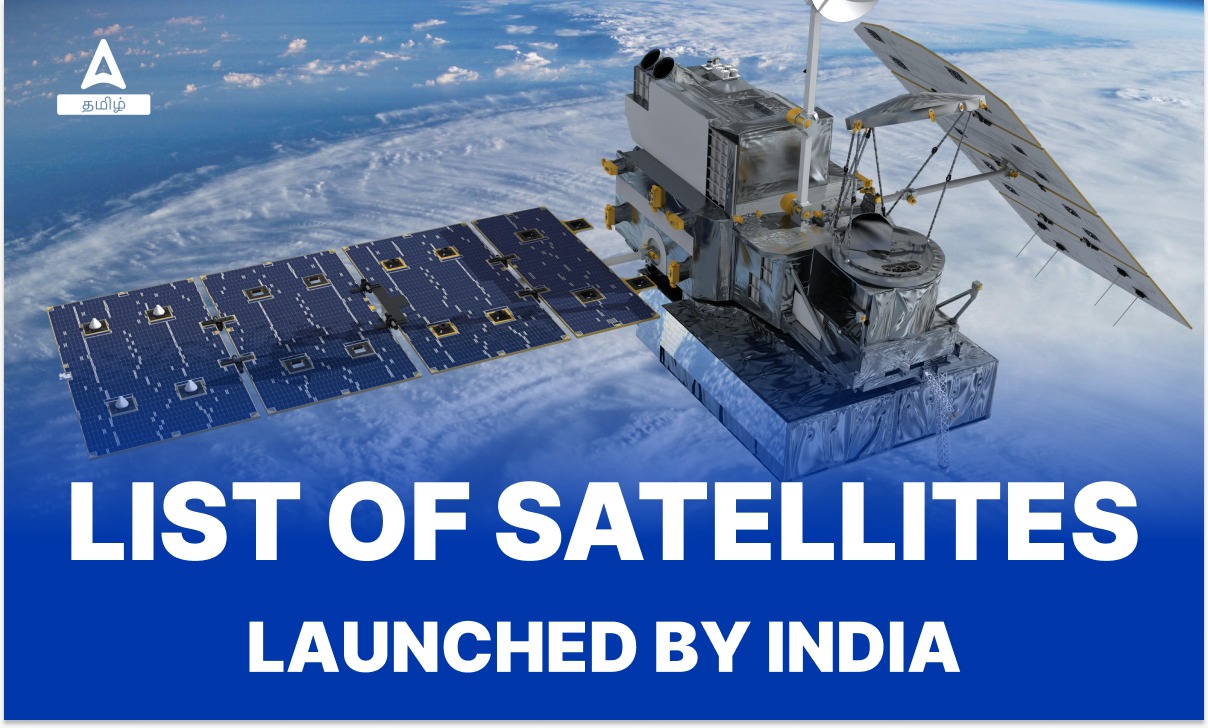Table of Contents
List of Satellites launched by India: A Satellite is a celestial body that moves around the planets in the same way as the planets move around the sun. India’s first Satellite was launched in 1975. Since 1975 India has been launching various types of satellites. This article gives you the List of Satellites launched by India from 1975 to 2023.
List of Satellites launched by India
List of Satellites launched by India: பல்வேறு போட்டி தேர்வுகளில் பொது அறிவு வினாக்கள் கேட்கப்படுகின்றன. அத்தைகைய பொது அறிவு இந்தியாவால் ஏவப்பட்ட சில முக்கிய செயற்கைக்கோள்களின் பட்டியலை இந்த கட்டுரையில் காணலாம். செயற்கைக்கோள்களின் பட்டியலுக்குச் செல்வதற்கு முன், செயற்கைக்கோள்கள் மற்றும் இஸ்ரோ பற்றிய சுருக்கமான அறிமுகத்தைப் பார்ப்போம்.
What is Satellite?
Satellites: சந்திரன் பூமியைச் சுற்றி வருவது போல் வானில் வேறு எதையாவது சுற்றி வரும் அனைத்தும் செயற்கைக்கோள் எனப்படும். செயற்கைக்கோள்கள் வானிலை முன்னறிவிப்பு, தொலைக்காட்சி ஒளிபரப்பு, வானொலித் தொடர்பு, இணையத் தொடர்பு, ஜிபிஎஸ் போன்ற பல்வேறு நோக்கங்களுக்காகப் பயன்படுத்தப்படுகின்றன. முக்கியமாக இரண்டு வகையான செயற்கைக்கோள்கள் உள்ளன:
- இயற்கை செயற்கைக்கோள்கள்: இவை ஒரு கிரகத்தைச் சுற்றி வரும் வான உடல்கள்.
- செயற்கை செயற்கைக்கோள்கள்: இவை ராக்கெட்டுகளின் உதவியுடன் பல நோக்கங்களுக்காக விண்வெளியில் ஏவப்படும் மனிதனால் உருவாக்கப்பட்ட பொருட்கள்.
செயற்கைக் கோள்களை விண்ணில் செலுத்தும் பல அரசு நிறுவனங்கள் உலகில் உள்ளன. அப்படிப்பட்ட ஒரு அமைப்புதான் இஸ்ரோ.
Natural Satellite – Moon

நமது பூமிக்கு ஒரே ஒரு துணைக்கோள், அதாவது சந்திரன் மட்டுமே உள்ளது. அதன் விட்டம் பூமியின் நான்கில் ஒரு பங்கு மட்டுமே. இது மற்ற விண்மீன்கள், வான் பொருட்களை விட நமது கிரகத்திற்கு அருகில் இருப்பதால் மிகவும் பெரியதாக தோன்றுகிறது. இது எங்களிடமிருந்து சுமார் 3,84,400 கிமீ தொலைவில் உள்ளது. சந்திரன் சுமார் 27 நாட்களில் பூமியைச் சுற்றி வருகிறது.
Human Made Satellites
மனிதனால் உருவாக்கப்பட்ட செயற்கைக்கோள் ஒரு செயற்கையாக உருவாக்கப்பட்ட துணைக்கோள்கள். இது பிரபஞ்சத்தைப் பற்றிய தகவல்களை சேகரிக்க அல்லது தகவல் தொடர்புக்காக விஞ்ஞானிகளால் வடிவமைக்கப்பட்டுள்ளது. இது ராக்கெட் மூலம் எடுத்துச் செல்லப்பட்டு பூமியைச் சுற்றியுள்ள சுற்றுப்பாதையில் நிலைநிறுத்தப்படுகிறது. விண்வெளியில் உள்ள சில இந்திய செயற்கைக்கோள்கள் INSAT, IRS, EDUSAT போன்றவை.
Fill the Form and Get All The Latest Job Alerts
What is the First Satellite Launched by ISRO?
இந்தியாவின் முதல் செயற்கைக்கோள் ஆர்யபட்டா. இது 5 ஆம் நூற்றாண்டின் கணிதவியலாளரும் வானவியலாளருமான ஆர்யபட்டாவின் பெயரால் அழைக்கப்படுகிறது.

- இது 1975 ஆம் ஆண்டு ஏப்ரல் 19 ஆம் தேதி, காஸ்மோஸ்-3எம் ஏவுகணையைப் பயன்படுத்தி அஸ்ட்ராகான் ஒப்லாஸ்டில் உள்ள சோவியத் ராக்கெட் ஏவுதளம் மற்றும் மேம்பாட்டுத் தளமான கபுஸ்டின் யாரில் இருந்து ஏவப்பட்டது.
- யு.ஆர்.ராவ் இயக்கிய இந்தியாவிற்கும் சோவியத் யூனியனுக்கும் இடையிலான ஒப்பந்தத்தின் காரணமாக ஏவுதல் வெற்றியடைந்தது மற்றும் ஒப்பந்தம் 1972 இல் கையெழுத்தானது. இந்த ஒப்பந்தம் சோவியத் ஒன்றியம், கப்பல்களைக் கண்காணிக்கவும், கப்பல்களை ஏவவும் மற்றும் இந்தியாவை அனுமதித்தால் அதற்குப் பதிலாக இந்திய போர்டல்களைப் பயன்படுத்த அனுமதித்தது.
- எக்ஸ்ரே ஜோதிடம், வேளாண்மை மற்றும் சூரிய இயற்பியல் ஆகியவற்றில் இந்தியாவுக்கு உதவுவதற்காக இந்த செயற்கைக்கோள் உருவாக்கப்பட்டது.
List of Indian Satellites
List of Indian Satellites: இந்தியாவின் முதல் செயற்கைக்கோள் 1975 இல் ஏவப்பட்டது. 1975 முதல் இந்தியா பல்வேறு வகையான செயற்கைக்கோள்களை விண்ணில் செலுத்தி வருகிறது. இந்தக் கட்டுரை 1975 முதல் 2022 வரை இந்தியாவால் ஏவப்பட்ட செயற்கைக்கோள்களின் பட்டியலை கீழே காணலாம்.
| Launch year | Satellite | Importance |
| 1975 | Aryabhatta |
|
| 1979 | Bhaskara Sega-I |
|
| Rohini Technology Payload | The First Indian launch vehicle Failed to achieve orbit. | |
| 1980 | Rohini RS-1 |
|
| 1981 | Rohini RS-D1 |
|
| Apple |
|
|
| Bhaskara-II |
|
|
| 1982 | INSAT-1A |
|
| 1983 | Rohini RS-D2 | Identical to RS-D1. |
| INSAT-1B |
|
|
| 1987 | SROSS-1 |
|
| 1988 | IRS-1A |
|
| SROSS-2 | Carried remote sensing payload of the German space agency and gamma-ray astronomy payload. | |
| INSAT-1C | Same as INSAT-1A. | |
| 1990 | INSAT-1D | Identical to INSAT-1A. |
| 1991 | IRS-1B | Improved version of IRS-1A. |
| 1992 | INSAT-2DT | Launched as Arabsat 1C. |
| SROSS-C | It carried gamma-ray astronomy and aeronomy payload. | |
| INSAT-2A | The first satellite in the second-generation Indian-built INSAT-2 series. | |
| 1993 | INSAT-2B | The second satellite in the INSAT-2 series. |
| IRS-1E | Earth observation satellite. Failed to achieve orbit. | |
| 1994 | SROSS-C2 | Identical to SROSS-C. |
| IRS-P2 | Launched by the second developmental flight of PSLV. | |
| 1995 | INSAT-2C | It has capabilities such as mobile satellite service, business communication and television outreach beyond Indian boundaries. |
| IRS-1C | Launched from Baikonur Cosmodrome. | |
| 1996 | IRS-P3 |
|
| 1997 | INSAT-2D | Same as INSAT-2C. |
| IRS-1D | Same as IRS-1C. | |
| 1999 | INSAT-2E | Multipurpose communication and meteorological satellite. |
| OceanSat-1 |
|
|
| 2000 | INSAT-3B | Multipurpose communication satellite. |
| 2001 | GSAT-1 |
|
| TES |
|
|
| 2002 | INSAT-3C | Augmented the INSAT capacity for communication and broadcasting |
| Kalpana-1 |
|
|
| 2003 | INSAT-3A | Multipurpose communication satellite, similar to INSAT-2E and Kalpana-1. |
| GSAT-2 |
|
|
| INSAT-3E | Communication satellite to augment the existing INSAT System. | |
| ResourceSat-1 | Intended to supplement and replace IRS-1C and IRS-1D. | |
| 2004 | EduSAT | India’s first exclusive educational satellite. |
| 2005 | CartoSat-1 |
|
| HamSat |
|
|
| INSAT-4A | Advanced satellite for direct-to-home television broadcasting services. | |
| 2006 | INSAT-4C | Geosynchronous communications satellite. Failed to achieve orbit. |
| 2007 | CartoSat-2 |
|
| SRE-1 | An experimental satellite that was launched as a co-passenger with CARTOSAT-2. | |
| INSAT-4B | Identical to INSAT-4A. | |
| INSAT-4CR | Identical to INSAT-4C. | |
| 2008 | CartoSat-2A | Identical to CARTOSAT-2. |
| IMS-1 | Low-cost microsatellite imaging mission. Launched as co-passenger with CARTOSAT-2A. | |
| Chandrayaan-1 | India’s first unmanned lunar probe. | |
| 2009 | RISAT-2 | Radar imaging satellite. Launched as a co-passenger with ANUSAT. |
| AnuSat-1 | Research micro-satellite. It has since been retired. | |
| OceanSat-2 | Continues mission of OceanSat-1. | |
| 2010 | GSAT-4 | Communications satellite with technology demonstrator features. Failed to achieve orbit. |
| CartoSat-2B | Identical to CartoSat-2A. | |
| StudSat | India’s first pico-satellite (weighing less than 1 kg). | |
| GSAT-5P | C-band communication satellite. Failed to achieve the mission. | |
| 2011 | ResourceSat-2 | Identical to ResourceSat-1. |
| YouthSat | Indo-Russian stellar and atmospheric mini-satellite. | |
| GSAT-8 or INSAT-4G | Communications Satellite | |
| GSAT-12 | Augmented the capacity of the INSAT system for various communication services. | |
| Megha-Tropiques | Jointly developed by ISRO and the French CNES. | |
| Jugnu | Nano-satellite developed by IIT Kanpur. | |
| SRMSat | Nano-satellite developed by SRM Institute of Science and Technology. | |
| 2012 | RISAT-1 | India’s first indigenous all-weather Radar Imaging Satellite. |
| GSAT-10 | India’s advanced communication satellite. | |
| 2013 | SARAL | Joint Indo-French satellite mission for oceanographic studies. |
| IRNSS-1A | The first of seven satellites in the IRNSS navigational system. | |
| INSAT-3D | It is a meteorological Satellite with advanced weather monitoring payloads. | |
| GSAT-7 | It is the advanced multi-band communication satellite dedicated to military use. | |
| Mars Orbiter Mission (MOM) or Mangalyaan-1 | India’s first Mars orbiter. | |
| 2014 | GSAT-14 | Intended to replace GSAT-3, and to augment the in-orbit capacity of Extended C and Ku-band transponders. |
| IRNSS-1B | It is the second of seven satellites in the IRNSS system. | |
| IRNSS-1C | It is the third satellite in the IRNSS. | |
| GSAT-16 | It has the highest number of transponders in a single satellite at that time (48 transponders). | |
| 2015 | IRNSS-1D | It is the fourth satellite in the IRNSS. |
| GSAT-6 | Communication satellite that marks the success of indigenously developed upper stage cryogenic engine. | |
| Astrosat | India’s first dedicated multi-wavelength space observatory. | |
| GSAT-15 | Communications satellite. | |
| 2016 | IRNSS-1E | It is the fifth satellite in the IRNSS. |
| IRNSS-1F | It is the sixth satellite in the IRNSS. | |
| IRNSS-1G | It is the seventh satellite in the IRNSS. | |
| Cartosat-2C | Identical to CARTOSAT-2,2A and 2B. | |
| SathyabamaSat | A micro-satellite designed and built by Sathyabama University, Chennai. | |
| Swayam-1 | A 1-U pico-satellite designed and built by the students of College of Engineering, Pune. | |
| INSAT-3DR | An advanced meteorological satellite | |
| Pratham | A mini-satellite built by students and researchers at IIT, Mumbai. | |
| PISat | A micro-satellite designed and built by the students of PES Institute of Technology, Bengaluru. | |
| ScatSat-1 | Miniature satellite to provide weather forecasting, cyclone prediction, and tracking services to India. | |
| GSAT-18 | The heaviest satellite owned by India at the time of its launch. | |
| ResourceSat-2A | Identical to Resourcesat-1 and Resourcesat-2. | |
| 2017 | CartoSat-2D | ISRO holds the world record for launching the highest number of satellites by a single launch vehicle. |
| INS-1A | One of 2 nano-satellites designed and manufactured by ISRO, as part of the constellation of 104 satellites launched in a single go. | |
| INS-1B | One of 2 nano-satellites designed and manufactured by ISRO, as part of the constellation of 104 satellites launched in a single go. | |
| South Asia Satellite | It is offered by India as a diplomatic initiative to its neighbouring countries (SAARC region) for communication, remote sensing, resource mapping and disaster management applications. | |
| GSAT-19 | It is the heaviest rocket (and the heaviest satellite) to be launched by ISRO from Indian soil. | |
| NIUSat | It is built by the students of Noorul Islam University, Kanyakumari. | |
| CartoSat-2E | 7th satellite in the Cartosat series to be built by ISRO. | |
| GSAT-17 | India’s 18th communication (and to date, its heaviest) satellite | |
| IRNSS-1H | First satellite to be co-designed and built-in collaboration with private sector assistance. Failed to achieve orbit. | |
| 2018 | CartoSat-2F | 6th satellite in the Cartosat series to be built by ISRO. |
| MicroSat-TD | It is a technology demonstrator and the forerunner for future satellites in this series. | |
| INS-1C | Third satellite in the Indian Nanosatellite series. It will carry MMX-TD Payload from SAC. | |
| GSAT-6A | A high power S-band communication satellite. It will also provide a platform for developing technologies. | |
| IRNSS-II | Eighth satellite of IRNSS. | |
| GSAT-29 | High-throughput Communication Satellite | |
| HySIS | Hyperspectral imaging services for agriculture, forestry, resource mapping, geographical assessment and military applications. | |
| ExseedSat-1 | India’s first privately funded and built satellite. | |
| GSAT-11 | Heaviest Indian spacecraft in orbit to date. | |
| GSAT-7A | Services for IAF and Indian Army. | |
| 2019 | Microsat-R | Suspected to have been destroyed in the 2019 Indian anti-satellite missile test. |
| PS4 Stage attached with KalamSAT-V2 | Used PSLV’s 4th stage as an orbital platform. | |
| GSAT-31 | Replacement of the ageing INSAT-4CR. | |
| EMISAT | Electromagnetic intelligence to track any enemy radars for IAF. | |
| PS4 Stage attached with ExseedSat-2, AMSAT, ARIS and AIS payloads | Utilization of the fourth stage directly as a satellite for experiments. | |
| RISAT-2B | Successor to old RISAT-2. | |
| Orbiter of Chandrayaan-2 | India’s second lunar exploration mission. | |
| Cartosat-3 | One of the optical satellites with the highest resolutions in the world. | |
| RISAT-2BR1 | Improved resolution of 0.35 metres. | |
| 2020 | GSAT-30 | Replacement of INSAT-4A. |
| EOS-01 | Space-based synthetic aperture imaging radar. | |
| CMS-01 | Extended C-band coverage for mainland India, Lakshadweep and Andaman & Nicobar Islands. | |
| 2021 | Sindhu Netra | Earth observation satellite used by Indian Navy for surveillance over the Indian Ocean. |
| SDSat | This Nanosatellite was developed by Space Kidz India to study radiations. It carried 25,000 names and a copy of Bhagavad Gita into space. | |
| JITSat | Developed by JIT as part of UNITYSat constellation. | |
| GHRCESat | Developed by GHRCE as part of UNITYSat constellation. | |
| Sri Shakthi Sat | Developed by SIET as part of UNITYSat constellation. | |
| EOS-03 | India’s first real-time Earth observation satellite and first satellite of the GISAT constellation. |
Tamil Books and Authors for TNPSC Exams
Indian Space Research Organization (ISRO)
Indian Space Research Organization: இந்திய விண்வெளி ஆராய்ச்சி நிறுவனம், இஸ்ரோ என்றும் அழைக்கப்படுகிறது, இது இந்திய அரசின் விண்வெளி நிறுவனம் ஆகும், இது பெங்களூரில் அதன் தலைமையகத்தைக் கொண்டுள்ளது. இது 1962 இல் புகழ்பெற்ற விஞ்ஞானி விக்ரம் சாராபாயால் நிறுவப்பட்டது. இந்த நிறுவனம் முக்கியமாக செயற்கை செயற்கைக்கோள்களை ஏவுதல் உட்பட விண்வெளி பயன்பாடு தொடர்பான ஆராய்ச்சி மற்றும் மேம்பாட்டு நடவடிக்கைகளில் ஈடுபட்டுள்ளது.
| Adda247 TamilNadu Home page | Click here |
| Official Website=Adda247 | Click here |
Adda247App | Adda247 Tamil Youtube
Adda247 Tamil telegram group –Tnpsc sure shot selection group
Instagram = Adda247 Tamil



